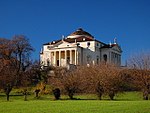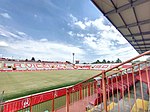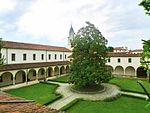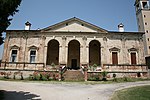Caserma Ederle

Caserma Ederle (Camp Ederle) is a military complex in Vicenza, Italy, where the United States Army has troops stationed. It is under Italian military control and can be managed anytime by the Italian authorities. The Vicenza Military Community is composed of soldiers, family members, civilians and retirees with a small number of airmen and sailors also stationed there. The post serves as the headquarters of United States Army Africa and the 173rd Airborne Brigade. Caserma Ederle serves as the headquarters of U.S. Army Garrison Italy of the United States Army Installation Management Command, an umbrella for all U.S. military properties in Vicenza. The post is named after Major Carlo Ederle, an Italian hero of World War I and recipient of the French Croix de Guerre (French War Cross), among other military honors.
Excerpt from the Wikipedia article Caserma Ederle (License: CC BY-SA 3.0, Authors, Images).Caserma Ederle
Vicenza San Pio X
Geographical coordinates (GPS) Address Nearby Places Show on map
Geographical coordinates (GPS)
| Latitude | Longitude |
|---|---|
| N 45.542416666667 ° | E 11.578505555556 ° |
Address
36100 Vicenza, San Pio X
Veneto, Italy
Open on Google Maps









